
Phlox is a genus of 68 species of perennial and annual plants in the family Polemoniaceae. They are found mostly in North America in diverse habitats from alpine tundra to open woodland and prairie. Some flower in spring, others in summer and fall. Flowers may be pale blue, violet, pink, bright red, or white. Many are fragrant.
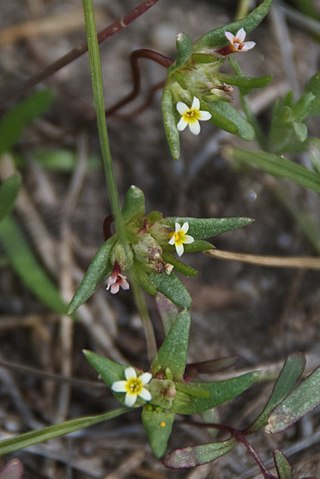
Gymnosteris parvula is a flowering plant in the phlox family known by the common name smallflower gymnosteris. It is native to the western United States from California to Montana. This is a small annual herb growing a thin green to red-colored stem only a few centimeters tall. There are no leaves; the word gymnosteris comes from the Greek for "naked stem". Atop the stem is a large, fleshy inflorescence with red-tinged green bracts that serve as leaves. Within the lobular inflorescence are one to five small flowers, each less than a centimeter long. The yellow-throated flower has yellow or white oval-shaped lobes with pointed tips. It is self-pollinating.
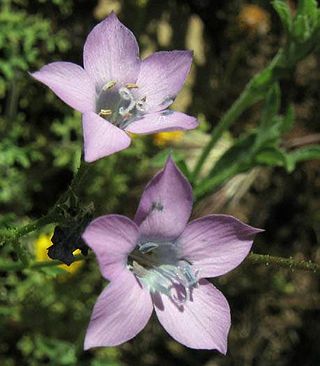
Saltugilia splendens, is a species of flowering plant in the phlox family known by the common names splendid woodland-gilia, Grinnell's gilia and splendid gilia.

Collomia tracyi is a species of flowering plant in the phlox family known by the common name Tracy's collomia. It is endemic to northern California, where it grows in the coniferous forests of the mountain ranges, including the Klamath Mountains. It is an annual herb producing a slender, branched stem no taller than about 8 centimeters. The glandular, hairy leaves are lance-shaped. The inflorescence is composed of two or three flowers emerging from the leaf axils. Each flower is white to lavender and up to 2 centimeters long. This species can be distinguished from the more common and widespread Collomia tinctoria by the positioning of the stamens and stigma in the flower.
Linanthus filiformis is a species of flowering plant in the phlox family known by the common name yellow gilia. It is native to the southwestern United States, where it grows in rocky desert and plateau habitat. This herb produces a threadlike, branching stem not more than about 15 centimeters long. It is generally hairless but may be thinly dotted with glands. The few linear leaves are up to 3 centimeters long and occur along the stem. The inflorescence generally bears one pair of yellow flowers, each flower under a centimeter wide.
Loeseliastrum depressum is a species of flowering plant in the phlox family known by the common name depressed ipomopsis. It is native to the deserts of the southwestern United States, where it grows in sandy habitat. It is a petite, decumbent annual herb forming a small clump on the ground, its hairy, glandular stems no more than 10 centimeters long. The leaves are linear to oval and pointed, each not more than 2 centimeters long. They are coated in white hairs. The inflorescence is a dense cluster of tiny white flowers, each pointed corolla lobe just a millimeter long or so.

Leptosiphon ciliatus is a species of flowering plant in the phlox family known by the common name whiskerbrush.
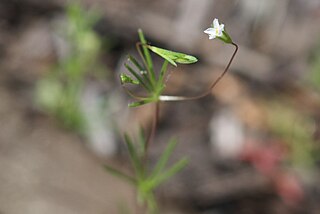
Leptosiphon harknessii is a species of flowering plant in the phlox family known by the common name Harkness' flaxflower.
Leptosiphon oblanceolatus is a species of flowering plant in the phlox family known by the common name Sierra Nevada linanthus.

Navarretia intertexta is a species of flowering plant in the family phlox, known by the common name needleleaf pincushionplant.

Phlox austromontana is a species of phlox known by the common name mountain phlox. It is native to the southwestern United States and Baja California, where it grows in forested and wooded mountain habitat, scrub, and open areas. It is a mat-forming perennial herb growing in patches of very short stems. The lance-shaped leaves are no more than 1.5 centimeters long and are arranged oppositely in pairs on the short stems. The inflorescence is a solitary flower at the tip of each stem. The flower is white or light pink or lavender with five rounded lobes. It is just over a centimeter long.

Phlox caespitosa is a species of phlox known by the common name tufted phlox. It is native to western North America from British Columbia through the Great Basin to New Mexico, where it grows in scrub, woodland, and other open plateau habitat. It is one of several cushion-forming species that occur in the same region and require careful observation to distinguish. In the past, this species and Phlox douglasii have been erroneously lumped together.

Phlox diffusa is a species of phlox known by the common name spreading phlox. It is native to western North America from British Columbia to the southwestern United States to the Dakotas, where it grows in many types of habitat, including rocky, high elevation mountain slopes. It is a very compact mat-forming perennial herb growing in cushions or patches of short, decumbent stems. The linear, lance-shaped, or needle-like leaves are no more than 1.5 centimeters long and are oppositely arranged in bundles on the short stems. The inflorescence is a solitary tubular flower around a centimeter long. It has a flat white or pale pink or blue corolla with five lobes each just under a centimeter in length.
Phlox dolichantha is a species of phlox known by the common name Big Bear Valley phlox. It is endemic to San Bernardino County, California, where it is limited to the area around Big Bear Lake in the San Bernardino Mountains. It grows in forests and the unique local pebble plain habitat. It occurs at elevations over 2000 meters. It is an erect, branching perennial herb growing up to 30 centimeters tall. The linear or narrowly lance-shaped leaves are 2 to 5 centimeters long and are oppositely arranged on the slender stems. The inflorescence is made up of one or more showy flowers at the tip of the stem. Each flower has a very slender tubular throat up to 5 centimeters long which can be white, pink, or lavender.

Microsteris is a monotypic genus of flowering plants in the phlox family containing the single species Microsteris gracilis, known by the common name slender phlox.
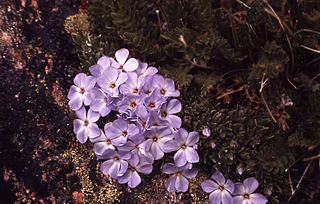
Phlox pulvinata is a species of phlox known by the common name cushion phlox. It is native to the western United States where it grows in mountain and plateau habitat, in rocky subalpine and alpine climates, including exposed tundra habitat. It is a perennial herb taking a flat, dense, cushionlike form on the ground. Its very short stems are lined with hair-fringed lance-shaped leaves each no more than one centimeter long. The plant is among the first to flower in the spring in many areas. It blooms densely, forming carpets of flowers. Each white to pale pink flower has a tubular throat up to one centimeter long and a flat five-lobed corolla.

Phlox speciosa is a species of phlox known by the common name showy phlox. It is native to western North America from British Columbia to Arizona and New Mexico, where it occurs in sagebrush, pine woodlands, and mountain forests.

Townsendia condensata is a species of flowering plant in the family Asteraceae known by the common names cushion Townsend daisy and cushion townsendia. It is native to North America where it is known from many scattered occurrences in the mountains of the western United States and Alberta in Canada. It is mainly limited to the alpine climates of high mountain peaks, where it grows in meadows, tundra, and barren, rocky talus. It grows alongside other alpine plants such as Eriogonum androsaceum.
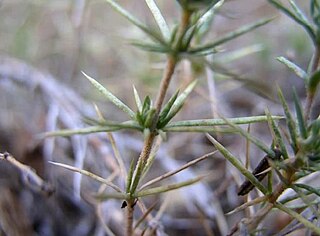
Linanthus watsonii is a species of flowering plant in the phlox family known by the common name Watson's prickly phlox. It is native to the western United States, where it occurs in Colorado, Idaho, Nevada, Utah, and Wyoming.
Physaria fremontii is a species of flowering plant in the family Brassicaceae known by the common name Fremont's bladderpod. It is endemic to Wyoming in the United States, where it occurs only in and around the Wind River Range in Fremont County.















